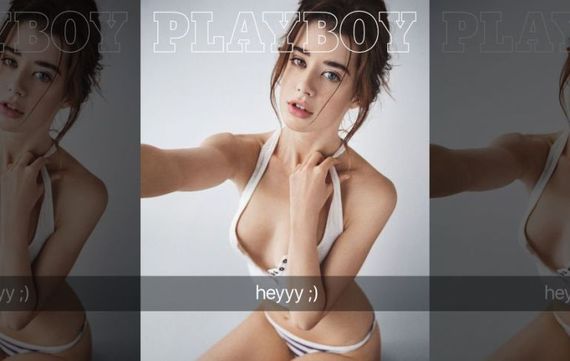Like many Americans, I picked up the March 2016 issue of Playboy looking forward to their new design without nudes. While a woman glared at me from a bench after she saw the magazine title, I took great amount of joy from being able to flip through the mag without first breaking a child-proof plastic wrap (which, c'mon, why has no one cashed in on the obvious condom jokes to be made here?), unfold the centerfold in public, then go home to finish the articles.
And for the first time, that was completely true. I read Playboy "for the articles."
While nothing can match their long-form articles and essays during the Seventies, Playboy is trying desperately to get back to the halcyon they once enjoyed. Founder Hugh Hefner has placed his Beverly Hills mansion on the block (with one caveat - the purchaser has to let him live there), the nudes are gone, the Playboy financial portfolio has been thinned out, merchandising has been cut back, and Hefner's son, Cooper, has been named Brand Ambassador to utilize the Hefner name with a youthful appearance.
A recurring complaint has been streaming from the Bunny Mansion - Hugh Hefner is old. And the coterie of women around him aren't feeling it. Playmate Carla Howe has said, "Most of the time all he wants is to play chess with his friends and watch old films. He almost never leaves home and refuses to change anything in the mansion. The whole place feels like it's stuck in the 1980's" and, what's worse, "Hef is so frail he goes everywhere with a group of nurses." For a brand built on youth, beauty, and energy, Playboy has increasingly reflected the ideals of an aging Hugh Hefner, which is why they desperately need to redevelop their brand once again for a new audience. Only this time, they're trying to rewind the clock entirely.
This isn't the first time Playboy has overhauled their brand. As Susan Gunelius, author of Building Brand Value the Playboy Way (2009) points out, Hefner's "primary goal [was] publishing a literary magazine for young men," a far cry from the excess and gaspy, airbrushed, gauzy Playboy became known for over the last three decades.
In 1984, Christie Hefner, Hugh's daughter, was named Chief Operating Officer after diminishing readership, numerous personal issues in Hugh's life which had begun to distract him from publishing and the bottom line. Christie shuttered the Playboy Clubs to expand the company into hardcore pornographic products, licensing, and media extensions like Play Television and Spice TV, Playboy.com and pay-per-view entertainment. Where her father sought to create high-brow decadence and cater toward refined sensibility, Christie "pornified" the company into what it represents in contemporary culture, defending all accusations of misogyny and destruction of morality with the passive explanation that she was, after all, a woman and this is what empowerment looked like. But in 2008, Christie resigned at the insistence of the board and even, it was rumored, at the request of her father. Readership of the magazine under the guidance of her father had once reached 5.6 million in 1975. During her oversight, it had fallen to 800,000.
The decline in readership has been attributed to many factors, especially the availability of free pornography on the Internet. But things had been bad for a long time. Magazines like Raunch, Playgirl, Larry Flynt's Hustler and Robert Guccione's Penthouse began replicating Playboy's success in the 1970's, regularly pushing the limits of publishing. These magazines flourished and eroded at Playboy by taking "the low road." Instead of aspiring to show the human form in tasteful, artistic ways, these magazines took pride in showing naked bodies without apology. Larry Flynt, for instance, claimed that he was the first publisher of "the full bush."
By the 1990's and 2000's, other magazines like Maxim, Stuff, and FHM continued to take away from Playboy's readership as their magazines were sold over the counter, without cellophane wrap to protect content from minors. Their centerfolds were provocative, but without nudity, emulating Playboy's original mindset and style. In 2008, Playboy began several rounds of layoffs and reconsidered the future of the future of the brand. Nothing was considered too drastic. For many, the dying gasps were already evident during the quasi-popular series The Girls Next Door on E! where a vaguely present Hefner shuttled "his girls" around the country for lackluster public appearances.
Except that's not exactly how it happened. With the company in trouble, investment markets in trouble, and investors putting their money towards interests other than a relic magazine, Hefner quietly began asking what it take to get his company back. Ultimately, as Robert Channick of The Los Angeles Times pointed out, "With nearly 70 percent of the Class A voting stock, Hefner's controlling interest -- and beefed-up offer -- ultimately swayed the board." After a $207.3 million buyout, "The Hef" had returned to the throne. But in a market racing for novel ways to accentuate the naked body, Playboy was been unable get traction. Playboy tried to rebrand itself no less than three times after the buyout, each time coming inevitably closer to where they now find themselves: a magazine that pioneered the naked body no longer wants to show the naked body.
"That battle has been fought and won," said Scott Flanders, Playboy's chief executive told The New York Times. "You're now one click away from every sex act imaginable for free. And so it's just passé at this juncture."
Click here for the rest of the article, courtesy of Sexuality & the City.

